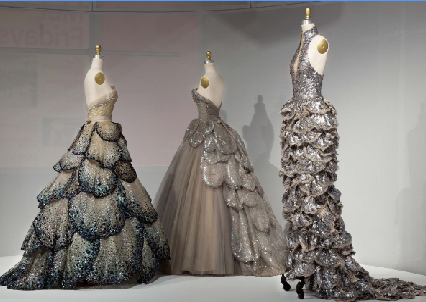This past Monday marked the opening of the Metropolitan Museum of Art’s Costume Institute exhibition, “Manus x Machina.” The annual Met Gala, a celebration of the opening, saw the movers and shakers of fashion decked out in futuristic and innovative costumes, befitting the theme. The exhibition itself is an exploration of “how fashion designers are reconciling the handmade and the machine-made in the creation of haute couture and avant-garde ready-to-wear,” as stated on the Met’s website. It’s an introspective exhibit—as all Costume Institute exhibitions are—that delves into the history of garment-making and the future of fashion design from the sewing machine to the 3D printer.
Emma Watson’s several-piece dress, designed by Calvin Klein and Eco Age, highlighted the actress’s efforts to bring sustainability to fashion. Made from recycled plastic bottles and organic materials, the dress itself could be repurposed and reused in different combinations. Zac Posen dressed Claire Danes in a custom organza gown, woven with fiber-optic lights that glittered in the dark, truly embodying the theme of the exhibit.
With “Manus x Machina” as well as the current “#techstyle” exhibition at the Museum of Fine Arts in Boston, fashion is unabashedly entering the digital age. Design houses like Louis Vuitton and Viktor & Rolf have made endeavors to explore the intersections of technology and artistic expression.
Of course, the fashion world is not the only industry experimenting with new technologies. The film industry is notorious for its fascination with computer-generated imagery (CGI), even more so in recent years as the technology not just advances, but becomes more accessible. James Cameron’s 2009 film “Avatar” was acclaimed as an artistic landmark of technological innovation. Large-scale films have only gotten larger with the ability to create entire worlds through CGI. We can explore the darkest depths of the ocean to the farthest reaches of a galaxy far far away through the imagination of artists and functions of a computer.
Then again, digital integration is not without its drawbacks. Within the film industry the big push towards CGI films has drawn backlash from more traditionally-oriented filmmakers. “The Hobbit” film trilogy, based on the original novel by J.R.R. Tolkien, was criticized for its excessive use of CGI, to the point of diluting the audience’s experience of the film. Films like “The Hobbit” that rely heavily on computer-generated imagery are often critiqued as looking cold and synthetic. One of the most universally acclaimed features of the original “Lord of the Rings” trilogy was its use of New Zealand’s scenery, which gave the films a special quality that was lost in the Hobbit films due to the heavy use of CGI.
As “machina” exponentially improves and expands, where does that leave art? Do we use technology to enhance the art we create, or does the art itself become secondary to utility? How do we define art in the digital age?
Technology has always had a unique relationship with art. It’s useful and utilitarian, able to help artists create works through traditional and digital means. Artists can even integrate machinery—old televisions, radios, computers, etc.—into their works to create new effects and meanings. Fine art museums have increasingly allowed and encouraged contemporary artworks with graphic art and mixed media.
Perhaps even technology itself can be considered art in the most abstract sense. Apple, a company famed for its technological innovation, is not only a leader in the tech world but also an aesthetic juggernaut. Apple’s slim Macbooks and iPhones are some of the most aesthetically pleasing devices on the market. It’s a marketing strategy in and of itself—beautiful things attract more consumers.
On a smaller scale, Wellesley’s own Davis Museum
is currently hosting the exhibition, “The Game Worlds of Jason Rohrer.” The Davis’s website states: “Rohrer’s work is deft, engaging, and often surprisingly moving. It refers to a diverse set of cultural influences ranging from the fiction of Borges to Black Magic; at the same time, it also engages pressing emotional, intellectual, philosophical, and social issues.”
It’s the first museum retrospective dedicated to a single video game creator ever, and again highlights the increasing presence of technology as art, specifically video games as art, in this case. And as we move towards a truly digital era, we will have to reexamine and reconsider our perceptions of art and its relationship with technology and digitization. Regardless, technology has made a home in the fine arts, changing the landscape for future generations.



